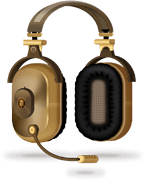
ARE YOU READY...

ARE YOU READY...
This curved piece connects the adjustable headband to the dome.
This allows CSRs to answer calls without needing to hit a button on their phones!
Old earphones covered the ear, but these cushions surround the ear for greater comfort and noise blocking.
The boom is an extension that holds the microphone and goes from the dome to the front of the CSR's mouth.

The clamp attaches the adjustable headband to the stirrup.
The headband can be made larger or smaller depending on how gargantuan your cranium is!
Headsets contain several filters within each ear piece.
This printed copper sheet electrically connects the headset's components.
Bow-shaped stirrups pivot on the dome, allowing you to adjust the ear cushions for maximum comfort.
They help diffuse the sound as it travels through headset speakers.
This is the inside view of the dome cover, and on the reverse is where the foam ear cushions are mounted.
While most headsets still use boom technology, boomless options are up and coming, eliminating the easy to break boom.
In typically noisy call center environments, these microphones are designed to filter out loud background sounds.
The speaker capsule encases a transducer, a device that changes the electrical energy from an amplifier into sound waves.
Windscreens protect the microphone from excess moisture.
Not all headsets are equipped with noise-canceling technology, making ambient sounds audible to callers.
They also help reduce plosive sounds made while talking, like pops from P and T.
A clamp kit on each side of the headband secures the headband to the right and left stirrups.
Some ear cushions are high-end, covered in velour or made of memory foam for extra comfort.
They help diffuse the sound as it travels through headset speakers.
Right and left domes house all of the headset's components.